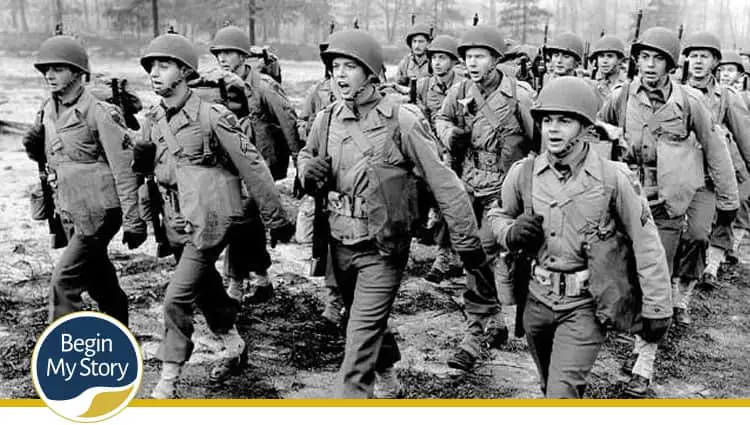
Use military records for ancestry and genealogy research.
Table of Contents
ToggleWhat are military records?
Military records kept by the United States government about soldiers and sailors who served their country are a significant source of information about individuals. The four significant wars of interest to historians and genealogists are the following:
- American Revolution (1775-1783). Approximately one out of every seven Americans fought in the American Revolution.
- Civil War (1861-1865). Approximately one out of every ten Americans fought in the Civil War.
- World War I (1918-1919). Over 4.8 million served in World War I
- World War II (1942-1945). Over 16 million served in World War II.
Check out these articles for more information:
- How to Find WWI Soldier Records for Writing Narratives
- How to Find WWII Soldier Records for Writing Narratives
- How to Find Civil War Soldier Records for Writing Narratives
- Meaning of Each Religious Emblem of Belief for U.S. Military Headstones
And these videos:
Because of these statistics, it is worthwhile to investigate the possibility that adult males (age 13 and up) who were alive during these wars may have fought in them. Many smaller wars have occurred in United States history, and there are records of genealogical value for those conflicts, which can be found at the state level. These wars and conflicts include the War of 1812, the Mexican-American War, the Spanish American War, and the Plains Indian Wars.
Information Found in Military Records
What information will you find in military records?
Military records provide basic information about a soldier, including the unit in which they served, dates of military service, and sometimes a date of death. There are three types of military records: service, pension, and History Records.
- Service Records. Service records cover the time an individual was actually in the service. These records almost always include a name, enlistment dates, attendance, discharge; beginning and ending rank; and military unit.
Use service records to learn about an individual’s military service, find the necessary details to locate a pension file or military history; learn place or date of birth (secondary source for this information); learn other details such as residence, occupation, or citizenship; find a physical description; find death or burial information; find medical information; find insights into the individual’s personality and performance (promotions, AWOL notations, and so on); and see if and where the individual was held as a prisoner of war (POW).
- Pension Records. Pension records cover the post-service period when the individual (or their next-of-kin) may have received benefits. They usually include a name, dates of enlistment and discharge, beginning and ending rank, and military unit.
Use pension records to learn about an individual’s military service, find the necessary details to locate a military history, learn place or date of birth (secondary source for this information), learn of dates and places of other life events, learn names of spouse or children (and sometimes their birth dates), learn other details (such as residence, occupation, or citizenship), find a physical description, find death or burial information, find medical information, gain insights into an individual’s personality and performance (through his letters, affidavits filed by others who knew him, and so on), learn of individual’s literacy, see individual’s signature, and learn more about individual’s post-war years and life.
- Military History. Military histories (often referred to as regimental or unit histories) can add historical background to help you understand the conflict and an individual’s participation in it. They usually include a roster of those who served in the unit and dates of significant engagements.
Use military history records to more fully appreciate the military experience of an individual, learn who they served with, learn which engagements they were involved in, and see what they looked like.
Other Resources to Help Search Individuals
Where can I learn more about how to trace ancestry?
The following are important articles for learning about ancestry and historical research.
- Introduction to Ancestry Research and Historical Records
- Why Search Multiple Records in Historical Family Research
- 5 Step Ancestry Research Process for Historians
- How to Use Naming Patterns in Ancestry Research
- How to Cite and Verify Ancestry Research
- How to Conduct Detailed Exhaustive Historical Research
- How to Use the Soundex Coding System
- 15 Strategies to Find Ancestor Names in Historical Records
- Keep Ancestry Research Focused with These 28 Simple Tips
Where can I learn more about records to trace ancestry?
The following is an overview of 15 types of vital, government and historical records I have found constantly valuable in my individual, family, and narrative research. These records provide vital and biographical information on individuals and families. When I mastered researching these resources, I could quickly expand my research to other records to help me connect the pieces for writing narratives and other historical research.
For each record type, I have included what you will find, how to use the resource, and research insights for each record type. I would encourage you to use this article as a starting point from which you can search out and find other record tutorials guides and help to provide deeper insights.
- Cemetery Records
- Census Records
- Certificates of Naturalization
- Church Records
- Civil Vital Records
- Court Records
- Diaries and Journals
- Directories
- Immigration Records
- Land Records
- Military Service Records
- Historical Newspapers
- Periodicals
- Photographs
- Probate Records
- Social Security Death Index
- Township, City, and State Histories and Biographies






